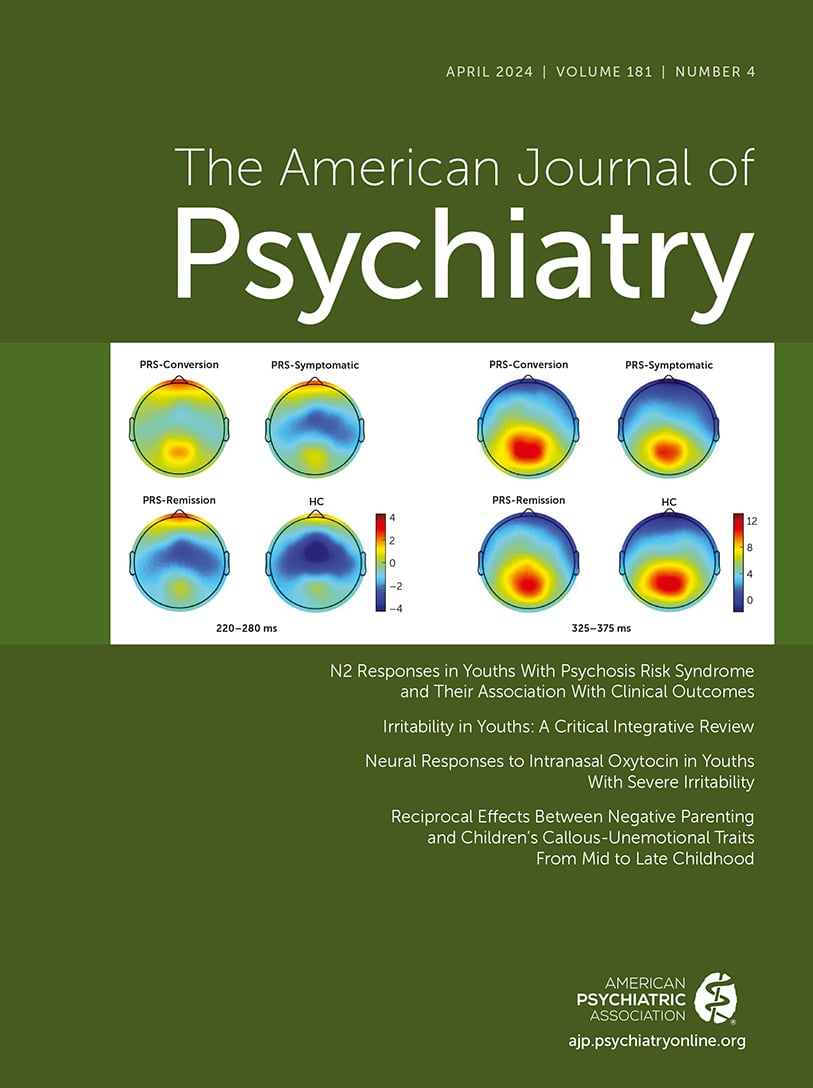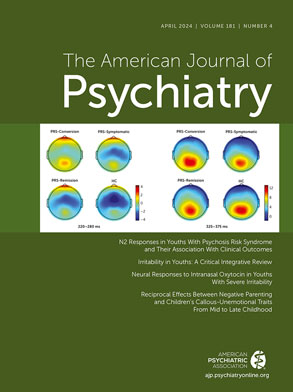Alcohol use disorder (AUD) has long been known to aggregate in families, and the prevalence of related disorders with which they are often comorbid (e.g., drug use and other psychiatric disorders) are also elevated in those families. Understanding the basis for both the comorbidity and the familial aggregation is complicated because families share both genetics and much of their environment, both of which contribute to risk. Disentangling these two sources of risk is important if we wish to gain insight into mechanisms of vulnerability from which to develop more effective preventions, identify potential drugs, and better target treatments to individuals (personalized medicine).
A study by Kendler et al. in this issue (
1) examined parent and offspring data from a large Swedish population sample (over 1.2 million offspring in intact families, 102,940 of whom had parents with AUD) to determine the relative magnitude of transmission of risk for five disorders (AUD, drug use disorders, attention deficit hyperactivity disorder [ADHD], major depression, and anxiety disorders) from parents with AUD to their offspring. They also evaluated differences between sons and daughters and whether the pattern of risk was similar when affected fathers were absent. Data came from Swedish medical and criminal registries, based on individuals born between 1970 and 1990 and their parents.
There are several important findings. First, the hazard ratio for offspring of a parent with AUD was highest for AUD (hazard ratio=2.36), followed by drug use disorders (hazard ratio=2.04) and ADHD (hazard ratio=1.82); hazard ratios for major depression and anxiety disorders were also elevated but not as much (both hazard ratios were 1.43). The hazard ratios for sons and daughters were similar, despite the difference in prevalence of AUD between men and women. The hazard ratio was stronger if both parents were affected: a hazard ratio of 4.64 for AUD in the offspring, which was 1.97-fold higher than if one parent was affected. The increased risk for drug use disorders was also elevated (1.7-fold higher); the effect was smaller for the other disorders (1.3- to 1.4-fold higher).
Another interesting finding was that the risk for offspring of affected mothers and fathers was essentially identical. This finding argues against the theory that because women are less likely than men to be affected with AUD, it would on average take a higher level of genetic risk to make them susceptible, which in turn implies that transmission of the genetic risk from affected women should be greater than that from affected men. One can therefore surmise that the difference between men and women in AUD prevalence results primarily from environmental factors that differ between sexes (e.g., societal norms around drinking) rather than an intrinsic genetic factor. The difference in prevalence of AUD between generations also highlights environmental (e.g., cohort) effects; AUD prevalence was lower in the offspring generation than in the parental generation (2.12% of mothers vs. 1.59% of daughters; 6.15% of fathers vs. 3.77% of sons). An analysis of families in which the father was absent for most of the child’s upbringing (51,003 children) showed a similar pattern of risk for AUD and the other disorders, although the hazard ratios were somewhat lower (e.g., approximately 1.9 vs. 2.36 for AUD; approximately 1.6 vs. 2.04 for drug use disorders). These findings suggest that the increased risk to offspring of parents with AUD is largely (but not entirely) genetic, and the role of environmental influences (child rearing during formative years) was smaller.
The hazard ratios of risk for the five disorders suggested to the authors that the levels of risk passed from parents with AUD to their offspring fell into a pattern, with the strongest risk more specific to AUD (the highest hazard ratio), then to drug use disorders, ADHD, and perhaps other externalizing disorders, and a lesser risk to both internalizing (major depression and anxiety disorders) and externalizing disorders. This is largely consistent with findings from other groups. Earlier studies by Kendler et al., also in the Swedish population, showed that individuals at high genetic risk for any one substance use disorder were at elevated risk for others (
2) and that there was a familial genetic risk that cut across both substance use disorders and many other psychiatric disorders (
3). Hatoum et al. (
4) found a common genetic risk factor underlying part of the risk for problematic alcohol use, opioid use disorder, cannabis use disorder, and problematic tobacco use, although there were also substance-specific factors. The general addiction factor was related to risk-taking and neuroticism among other traits (
4), and 19 single-nucleotide polymorphisms were associated with this general addiction factor (
5).
There are several strengths of the Kendler et al. study. One is the very large sample, which is relatively homogeneous compared with what would be found in the United States, for example. Another is that use of the registries did not require recruitment of the individuals. This reduces participation bias, which can be significant when the disorder carries stigma (e.g., substance use disorders and psychiatric disorders), when the disorder results in diminished capacity for participation, or when a subset of the population with the disorder is distrustful of the investigation and reluctant to participate. The individuals in the study did differ slightly from the general Swedish population: slightly better educated, more rural, and more likely to live in southern Sweden. Survivor bias may be significant when a study population includes mostly older individuals (e.g., the UK Biobank and the Million Veteran Program) and the trait of interest is associated with earlier mortality or renders an individual’s participation less likely (e.g., cognitive decline). The inverse can also be a bias if the age of many participants is not sufficiently past the usual age at onset of the disorder, which may lead to many false negatives. Kendler and colleague’s use of the Swedish registries with data over a broad time span, assessing offspring with an average age of 37.7 years at follow-up, reduces these biases. Another advantage of this study is the focus on substance use disorders (AUD and drug use disorders) instead of consumption of alcohol or drugs. Studies have shown that the genetics of consumption differs from that of substance use disorders, although there is considerable overlap, and that substance use disorders correlate more strongly with other psychiatric disorders (e.g.,
4–
8).
There are some limitations of this careful study, many of which are general to most large studies. The study subjects were not directly assessed by interview. Registries identify individuals who have come to the attention of either medical or legal authorities. The low rates of AUD in this sample of parents and offspring suggest that these registries miss many cases and are probably enriched in the more severe cases that triggered detection. Hazard ratios might be lower in cases of lesser severity, although the general pattern might hold. The comorbidity of these disorders could affect results from cross-disorder hazard ratios, although Kendler and colleagues report that it does not appear to be a major factor in their findings—hazard ratios dropped only slightly when the analyses omitted individuals in whom the secondary diagnosis was earlier than that of AUD. Of course, because AUD and drug use disorders are affected by the environment, and there are likely interactions between genetic and environmental factors, findings in one setting (Sweden, in this case) might not be the same in a very different setting, although the basic biology is likely to be similar.
It is important to move from large studies of phenotype, such as this one, toward understanding the biology behind differences in risk (
9). The genetic contribution to risk for substance use disorders is generally about 50% of the overall risk, distributed among thousands of variants across the genome, and the effect of any one variant is usually very small. The large samples needed to reliably detect the effect of a variant are nearly always characterized by both heterogeneity and superficial assessments. Smaller studies with robust and detailed phenotyping of the participants can help us understand the findings. Another issue is that groups of variants travel together along the chromosomes (linkage disequilibrium) in patterns that differ among different ancestral populations. The variant with the strongest statistical effect on a trait might not be the one that actually affects the trait; that variant merely marks a (generally large) locus containing many other variants. Detailed functional studies are required to identify which variants within the locus contribute to the mechanism behind the increased risk (
9). Studies of many populations in different environments with different linkage disequilibrium patterns can narrow the locus, aid in understanding gene-environment interactions, and allow the results to be applied equitably to people of a variety of ancestries (
9,
10). Some have dismissed the value of finding variants of small effect, but that misses the larger point: the effect size of a variant that leads to identification of a gene or pathway that influences the manifestation of the disorder does not limit the potential efficacy of modulating that pathway with a drug, and the biological knowledge gained can potentially be used to identify better drug targets and to better direct them to particular individuals (
9).
Moving forward, a combination of large-scale genetic studies and smaller studies with deep phenotyping, done across many populations and socioeconomic groups, followed by functional studies, should greatly increase our understanding of the mechanisms that contribute to risk for substance use disorders, provide targets for drug design and repurposing, and allow individualized treatments of patients with these disorders.

